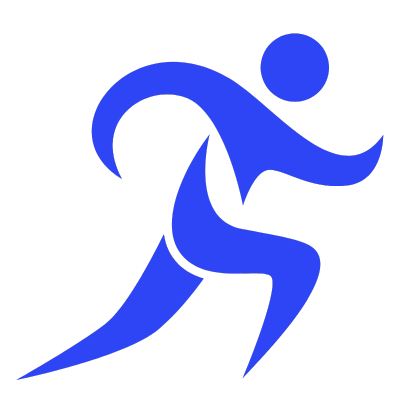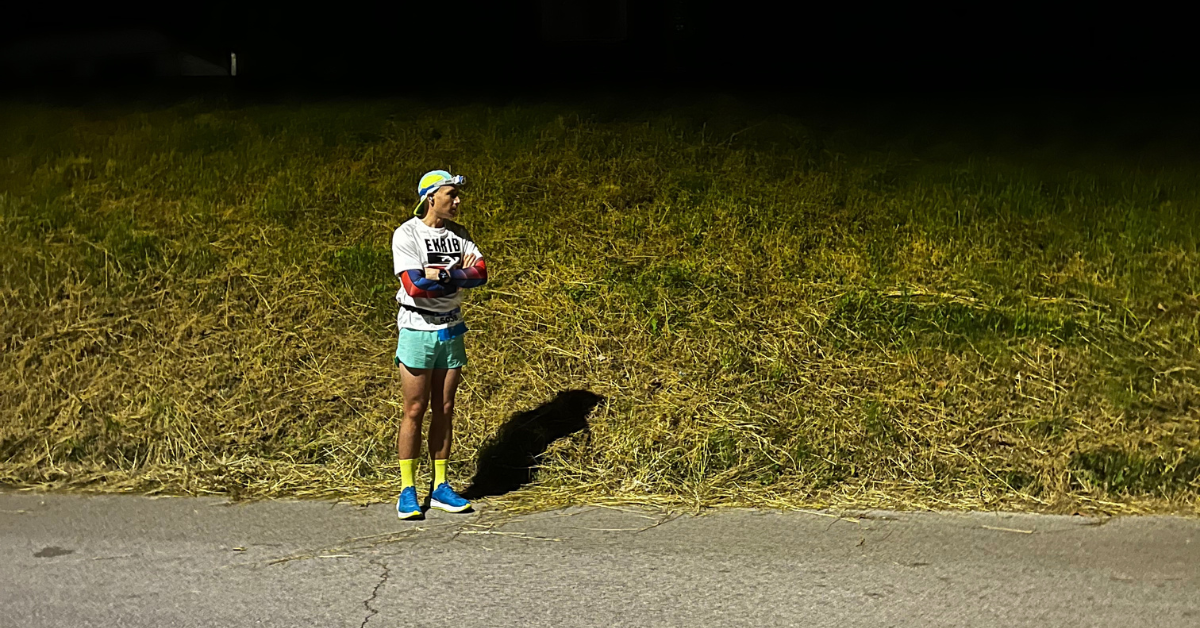On May 19th, 2024, I took on the Salomon Ultra Trail Hungary 111km in Szentendre, Hungary. This challenging trail race features 4200m of elevation gain. As a run coach and avid runner, I’m always eager to take on various challenges. This year, I returned to the Salomon Ultra Trail Hungary with a personal mission. Last year, due to a miscommunication (my Hungarian wasn’t quite up to speed), I mistakenly left my headlamp in my drop-bag instead of my pack. When my gear was checked at the finish, the headlamp was missing, resulting in a DNF. This year, I was determined to complete the race, have fun, and finally earn those medals!
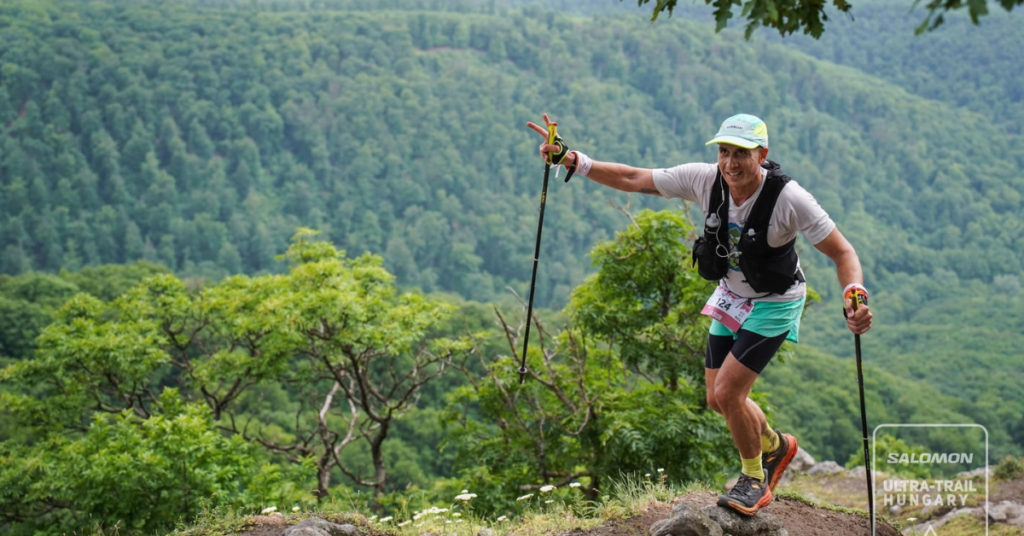
Training and Preparation: Ready for the Challenge
For May, I had two major races on my calendar: the Ultra Trail Hungary 111km and the UltraBalaton 5-person relay on May 3rd. With just two weeks to recover between them, I started my training in January 2024, following the phases of the Lydiard Pyramid.
- Aerobic Base Phase (6 Weeks): Although shorter than ideal, I relied on my strong base from the previous year. I ramped up my mileage to over 100km per week from the second week of January, including key sessions like PCR runs and fartleks.
- Hill/Strength Phase (3 Weeks): Focused on leg strength and form with more hill sessions. I also extended my long runs to consistently hit 2 hours and 45 minutes or more weekly, while also increasing the duration of my easy runs during the week.
- Anaerobic Phase (4 Weeks): Aimed at building speed for the UltraBalaton relay, this phase included longer interval sessions and tempo runs to improve running economy.
- Integration Phase (4 Weeks): Combined all training elements, with long, fast flat tempo runs, trail running, and steady high-incline treadmill runs. An important session was 10k at marathon pace followed by 10k at half-marathon pace with 5km easy in the middle.
- Taper Phase (10 days prior to UltraBalaton, if you can call it a taper): I didn’t taper too hard for the UltraBalaton relay, treating it as a hard, long session before the Ultra Trail Hungary. I was working at a conference the week before UltraBalaton, which required me to be on my feet for 16 hours daily for 2 days and get minimal sleep. My final long run on the trails was one week before the race, at an easy pace, to test my gear.
This year, I switched from High-5 Aqua Gels to Nduranz Gels, which offer 45g of carbs per gel, meeting half of my 90g per hour carb goal. I planned to supplement this with an isotonic drink (90g carbs per 500ml), coca-cola at aid stations, bread, and pogácsa (a Hungarian cheese-topped pastry, I love it).
I set three goals: A) finish under 13 hours (ambitious), B) finish under 15 hours (fun day out), and C) just finish (if things went wrong). Despite concerns about my lack of trail training, I felt fitter than last year and was determined to complete the race.


Pre-Race: Anticipation Builds
I took the HEV (Suburban Railway) to the race center, aiming for a relaxed start to the day. Leaving home in Budapest at 8:45 PM. I arrived at the race center by 10:15 PM, early enough to prepare for the midnight start. After picking up my race pack, I laid out my gear, prepared my drop bags, listened to music, ate some food, drank an energy drink, and made a few trips to the restroom to ensure I was ready to run. As the start time approached, I headed to the start line for the mandatory gear check.
This day, I woke up around 8 AM and had tortellini for breakfast, followed by pizza for lunch. Throughout the day, I sipped on Coca-Cola and water, with some beetroot juice for good measure. I also took a nap and spent most of the day lying in bed, trying to keep my steps below 5000. Despite my efforts, the walk from the train station to the race center pushed my total to 8000 steps for the day.
Race Start: Charging Ahead
I slowly made my way from the race center to the start line at about 11:30 PM, a short 500-meter walk downhill (which felt like a significant climb on the return trip after the race). The start area was already full with activity, packed with around 200 other adventurers ready to tackle the 111km distance. The atmosphere was exciting, with announcers speaking both English and Hungarian, giving the event a truly international feel. I took some videos, listened to my music, and tried to calm my mind, focusing on the adventure ahead and reminding myself to have fun no matter what. Confident in my ability to finish, I felt ready to go. No stretching or warm-up was necessary; conserving energy for the long journey ahead was paramount. The weather was clear and calm, but heavy rain was forecasted, adding an element of uncertainty to the race conditions.
At the start, I hit the first two checkpoints at my predicted sub 13-hour pace. I felt strong, with my legs and lungs in sync, and my mind focused. Running through the night added an element of adventure, making it more exciting. The initial stretch felt like it was all uphill, presenting a unique challenge in the dark. My headlamp flickered off at one point, switching to battery saver mode and dimming the light I managed to get past this hurdle. However, this forced me to slow my pace and stick close to others (as best as possible, but the race was already thinning out) on rough terrain to avoid injury.
Additionally, my fully loaded pack started bouncing excessively, causing some painful chafing. This issue hadn’t come up during my race tests. So I had to adjust my running style, holding the pack with my arms to minimise the bouncing and resulting pain. Despite the discomfort, I tried to ignore it and push through.
I met a fellow runner at an aid station who had dropped out due to vomiting and offered me his pack. In hindsight, I wonder if swapping packs would have improved my run and made the experience more enjoyable. Throughout the night, I recorded videos to document the adventure and share the thrill of trail running with others. It’s an experience I believe everyone should try at least once.
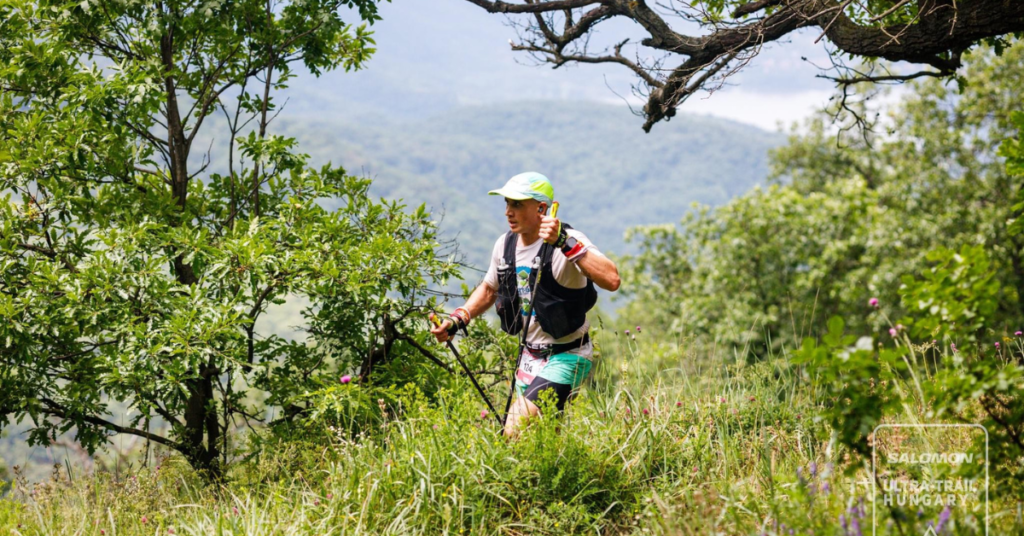
Mid-Race: Navigating the Journey
Daybreak marked the start of the mid-race segment. The night had been filled with relentless hills, both steep and technical. Navigating these downhills with a dim headlamp and no company was a challenging but rewarding experience. The lesson here: always bring a backup battery or another lamp. As dawn broke, I enjoyed a pogácsa, then witnessed a beautiful sunrise through the trees—a stunning view after a tough climb. I paused to capture the moment with a video (here you can see the video, not just of this view, but of the whole race).
Just as the sun rose, clouds rolled in, and the rain began. The trails transformed from runable paths to slippery mudslides, significantly increasing the difficulty. I hit a low point, feeling down and unmotivated, contemplating giving up due to chafing, cold, and exhaustion. However, the thought of meeting Melinda at the finish line kept me going and I didn’t want to figure out the logistics of a bus ride home, tired, wet, and muddy.
Fortunately, I met another runner who invited me to pass, thinking I was faster. Instead, I stuck with him, grateful for the company. We ran together for about 5-10km through rough terrain, chatting about his UTMB TDS experience and work at Breville. Such encounters are the essence of ultras, where camaraderie flourishes.
After a brief road section, we parted ways, and I used my UltraBalaton training to make up time. I tackled a steep climb and then attempted to “ski” down using my poles, only to end up sliding on my ass, resulting in lots of funny comments from other runners for the rest of the race talking about my backside. I washed my hands in a stream at the bottom of the slide which was a refreshing pause before continuing on.
Another memorable moment was meeting a French runner who had lived in Hungary for 20 years and had done this race four times. We ran together for a couple of kilometers until the route veered left and climbed again. My gym training had paid off, making these climbs manageable, even when they required hands-and-knees scrambling up tree-rooted paths.
The aid stations were staffed by incredibly helpful volunteers. Recognising my non-Hungarian speaking status, they spoke English, helped refill my bottles, and kept the Coca-Cola flowing (definitely better than Pepsi in all regards). Some aid stations had a party-like atmosphere, with music and fires adding a touch of warmth and cheer.
Nutrition-wise, I stuck to my plan: one gel per hour, 500ml of ISO drink mix, and Coca-Cola and bread at aid stations, with an occasional pogácsa. Everything was going smoothly. I did need two toilet breaks, thanks to the pre-race pizza not fully digesting, but these didn’t indicate any stomach problems, just part of the adventure.
Frequent peeing confirmed my hydration was on point, despite the 100km mark approaching I was still peeing. Clear urine, except for the beetroot-induced red tint in the early stages, reassured me I was consuming enough fluids. This was a small but crucial victory in such a demanding race.
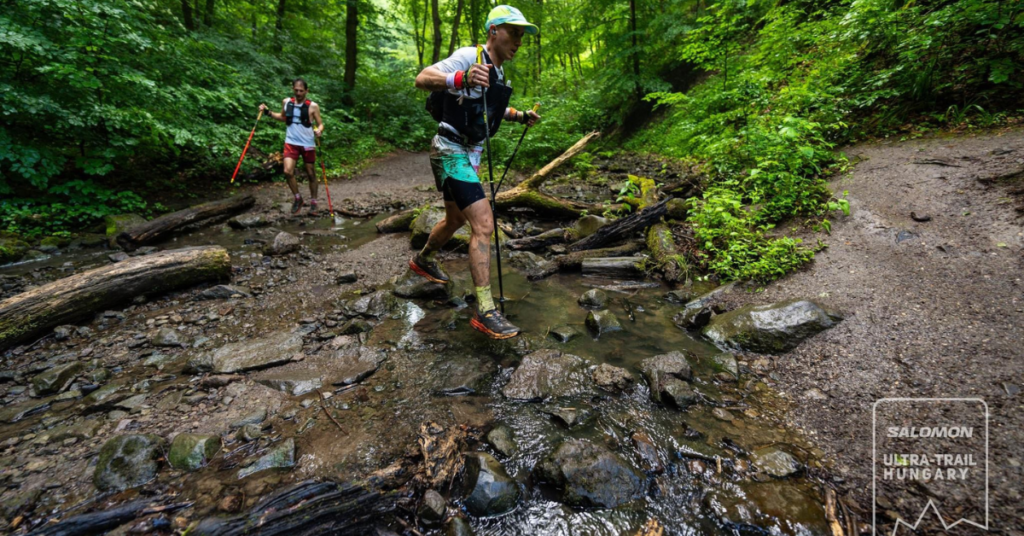
Late Race: Pushing Through Challenges
As the race wore on, fatigue set in, and my motivation wavered. The chafing on my neck and now also between my legs worsened, though vaseline provided some relief. My legs felt heavy from around the 80km mark, a consequence of both the race and my recent participation in the UltraBalaton relay, which left me with insufficient recovery time. Despite the physical strain, my mind took over. With only 30km to go, I reminded myself that my final long run had been 30km with over 1000m of elevation gain. The remaining distance, with 800m+ elevation, seemed manageable.
The sun replaced the rain, bringing intense heat and humidity. I kept my nutrition strategy in place, consuming gels and bread with cheese—a delightful surprise that my body craved—along with Coca-Cola and water. The ISO drink had become too sweet, so I compensated by eating more bread to maintain my calorie intake.
Though familiar with the course, I still encountered a few surprises. The most daunting was the steep climb at the 98km mark, just before the 100km point. At this stage, every step was a struggle. This hill was challenging even if it was at the start of a race, let alone after 98km. Yet, climb I did, using my poles for support. My arms, now fatigued, had to push through arm pain as well. Reaching the top provided a brief respite, only to discover more climbing awaited.
The subsequent descent was brutal, winding down the hill seemingly forever. The race course had changed from the previous year, making it difficult to gauge the distance to the next checkpoint. This uncertainty added to the mental challenge. Additionally, my right-hand Leki glove, which clips onto my pole for ease of use, broke. I had to revert to using the poles manually, which was a minor but notable inconvenience.
Upon reaching the final checkpoint, I paused to regroup. I knew from last year not to rush through, as the last 6km offered no shade and the heat was cruel. I sat down, drank some Coca-Cola (a potential sponsor for race fuel!), refilled my water bottles, checked my gear, and stowed my poles. Confident I would finish under 15 hours, I set off on the final stretch, running along the pavement towards the finish line.


Crossing the Finish Line: Triumph and Relief
Finishing the Salomon Ultra Trail Hungary is an experience like no other. As you enter the picturesque town of Szentendre, you run across cobblestone streets, passing by quaint art shops, cafes, and bakeries that define the town’s charm. The locals and tourists look on, puzzled by the sight of mud-covered, exhausted runners navigating their way through the town. The sound of a cowbell catches your attention, guiding you towards the finish line. As you move through the streets, more people begin to understand your journey. Tourists sipping their coffees start to clap, and it’s an incredible feeling of accomplishment and community.
Descending a small hill, you enter the finisher’s chute. The crowd’s applause grows louder. The announcer calls out your name—adding a personal touch to the moment. In my case, the announcer who was from the same town as Melinda, Hódmezővásárhely, even gave her a shout-out. With a final burst of energy, you cross the finish line, feeling a mix of relief and triumph.
Crossing the finish line isn’t the end of the process. You head into a tent for a mandatory gear check. The volunteers ensure you have your headlamp, ID, water bottles, phone, emergency blanket, and waterproof jacket. Despite the adrenaline, there’s a lingering worry that you might have missed something, especially given my previous year’s mishap with the headlamp.
Once the check is complete, you receive your hard-earned medals. For me, it was both the finisher medal and the coveted sub-15 hour medal, a rare achievement. Finishing in 14 hours and 27 minutes, I felt a profound sense of pride.
Physically drained, I found a place to sit. Melinda came over with the dogs to congratulate me and handed me a Coca-Cola. My friend Robi, who was part of the UltraBalaton relay team, was there with his wife, providing a warm, supportive presence. To my surprise, more friends—Chappie, Anna, and their daughter Hanna—showed up. Chappie even brought me a kenyérlángos (Hungarian bread, with fat, onion, and sour cream), which I devoured. It was the perfect end to an epic adventure, surrounded by friends and the promise of rest. All that remained was the journey back up to the race center and the walk to the HEV.
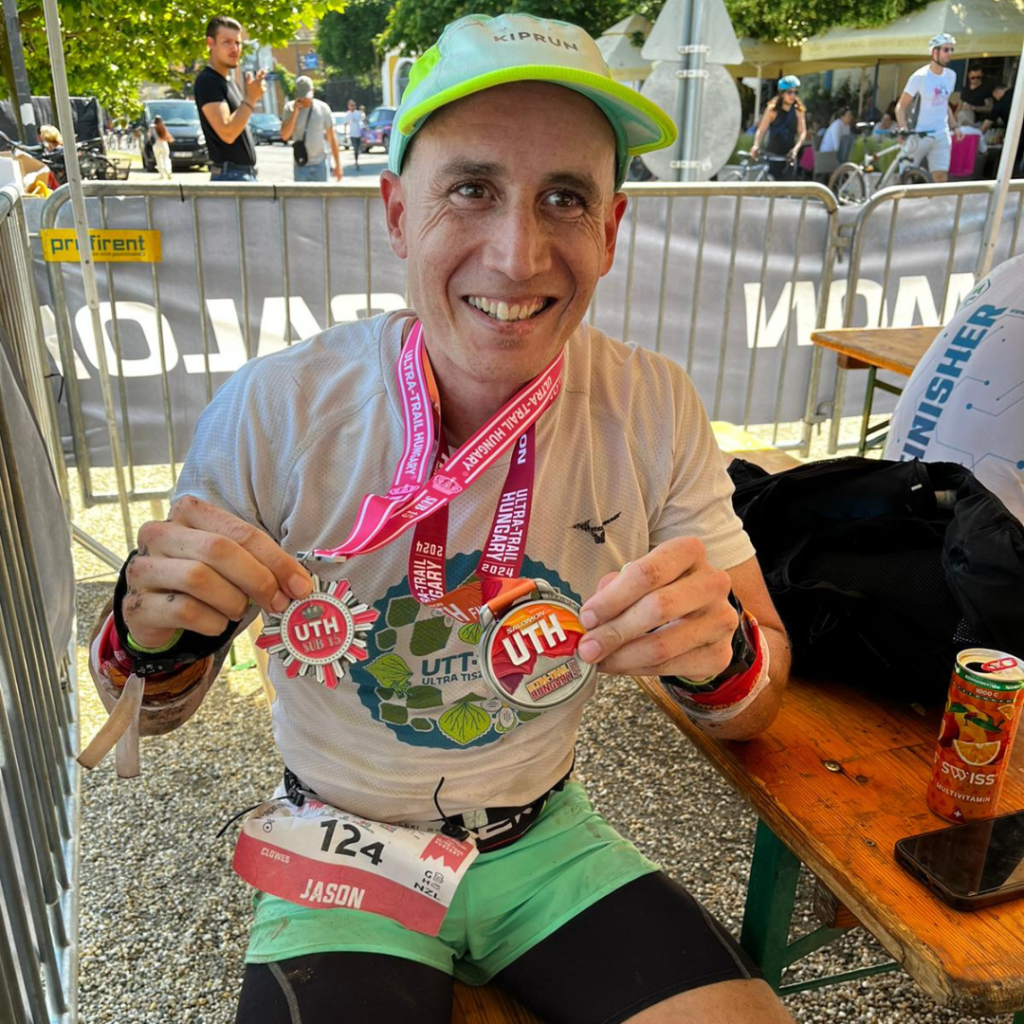

Post-Race Analysis: Insights and Reflections
My official time of 14 hours, 27 minutes, and 12 seconds landed me in 24th place overall out of 210 participants who started the race. While I aimed for a more ambitious sub-13-hour finish, the challenging weather conditions forced me to adjust my goals. Ultimately, I prioritised enjoying the experience and completing the race in under 15 hours, both of which I achieved.
Reflecting on this race, several key lessons emerged:
- Training Efficiency: I discovered that consistent training over a prolonged period is more valuable than long runs exceeding four hours. My longest run leading up to the race was just 3 hours and 45 minutes, yet the rest of my training proved sufficient for the demands of the race.
- Strength Training: Incorporating strength workouts at the gym significantly aided in tackling steep hills and combating arm fatigue from using poles.
- Treadmill Hill Workouts: Tread-hill sessions were instrumental in building the strength necessary to run some hills while others resorted to walking.
- Nutrition Strategy: I recognised the importance of consuming solid foods early in the race to sustain energy levels. Proper nutrition is crucial for performance, and I aim to refine my approach to avoid hunger and dehydration during future races.
- Race Strategy: While I prioritised enjoying the race, I realised the need to refine my pacing strategy for longer distances beyond the marathon. Additionally, having a support crew at aid stations could alleviate the burden of carrying excessive gear.
- Gear Selection: Despite feeling comfortable during training runs, my race bag didn’t perform as expected. This highlights the importance of testing gear under race conditions and making necessary adjustments.
Looking ahead, I have several races on my running horizon. Firstly, I aim to return to the Salomon Ultra Trail Hungary, intrigued by the goal of going Sub-13-hours. Whether I stick to the UltraBalaton relay or attempt the full 211km solo remains to be seen. Additionally, my sights are set on the Ultra Trail Julian Alps in September 2024, a challenging 120km event in Slovenia. The completion of the Salomon Ultra Trail Hungary this year has bolstered my confidence for this upcoming race, though achieving a sub-13-hour finish will undoubtedly be a big task. In the immediate future, I have a 23km trail race in the Hanua Ranges, New Zealand. While prioritising recovery, I’m excited for the adventure in the Hanua Ranges ahead, whether it unfolds as a competitive race or simply a day of enjoyment on the trails.
I want to extend my thanks to my incredible support crew, Melinda, my partner, and Pacsi, our loyal dog. Their unwavering encouragement throughout my training and their dedication to being there at the finish line mean the world to me. Pacsi, with his adventurous spirit, might enjoy the journey to the races even more than the waiting around at the finish line, but both Melinda and Pacsi’s presences are invaluable. Additionally, a special mention goes to the Running Latte Club for curating a playlist that provided over 13 hours of motivating music, perfectly embodying the spirit of the club.
Currently, I don’t have any sponsors, though I am open to the possibility (wink, wink). For this race, my gear included:
- Trail Shoes: Hoka Speedgoat 5’s
- Race Pack: Salomon Adv Skin 12 size L (which I’m looking to sell and replace with a size M or S)
- Poles: Leki Poles
- Clothing: A T-shirt from a previous race, shorts, and a hat from Decathlon
- Headlamp: Petzl, which I picked up free after a win at Ultra Trail Nagymaros a 2 years ago.
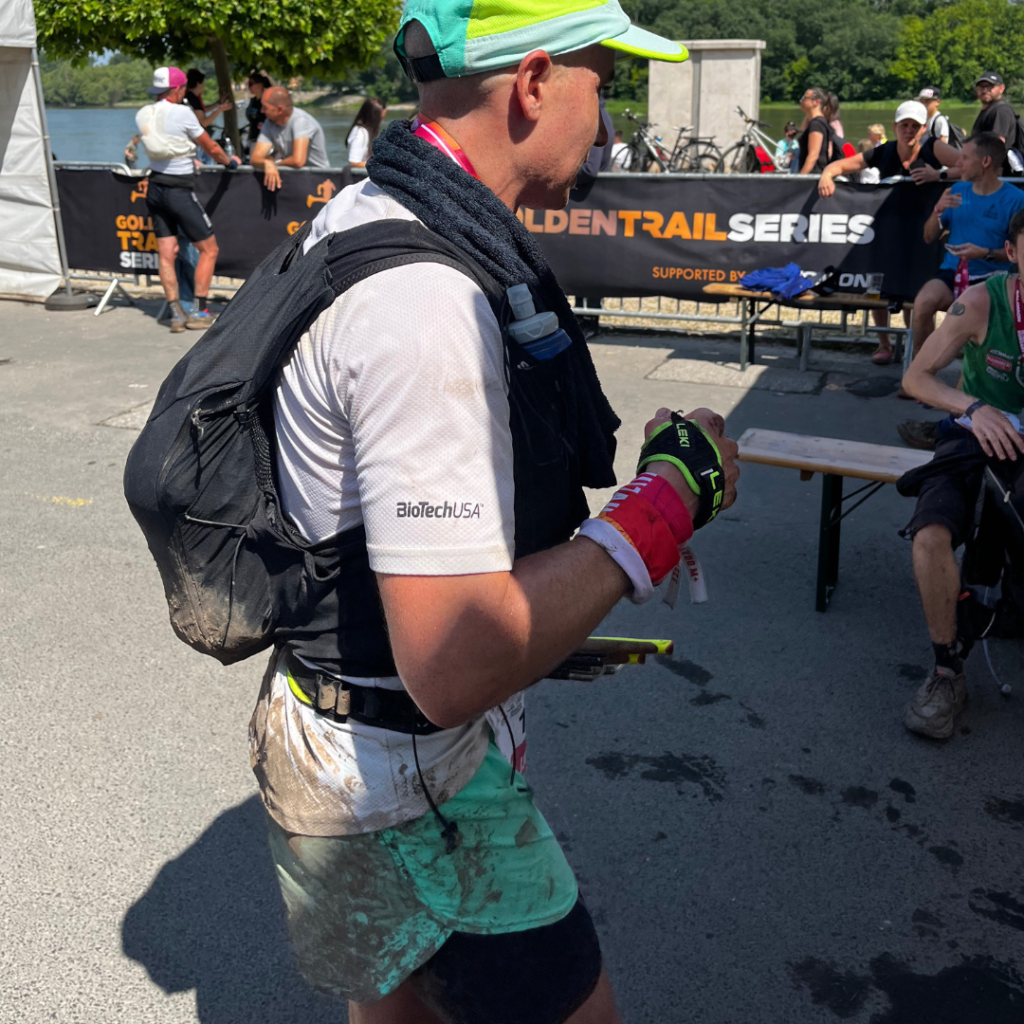
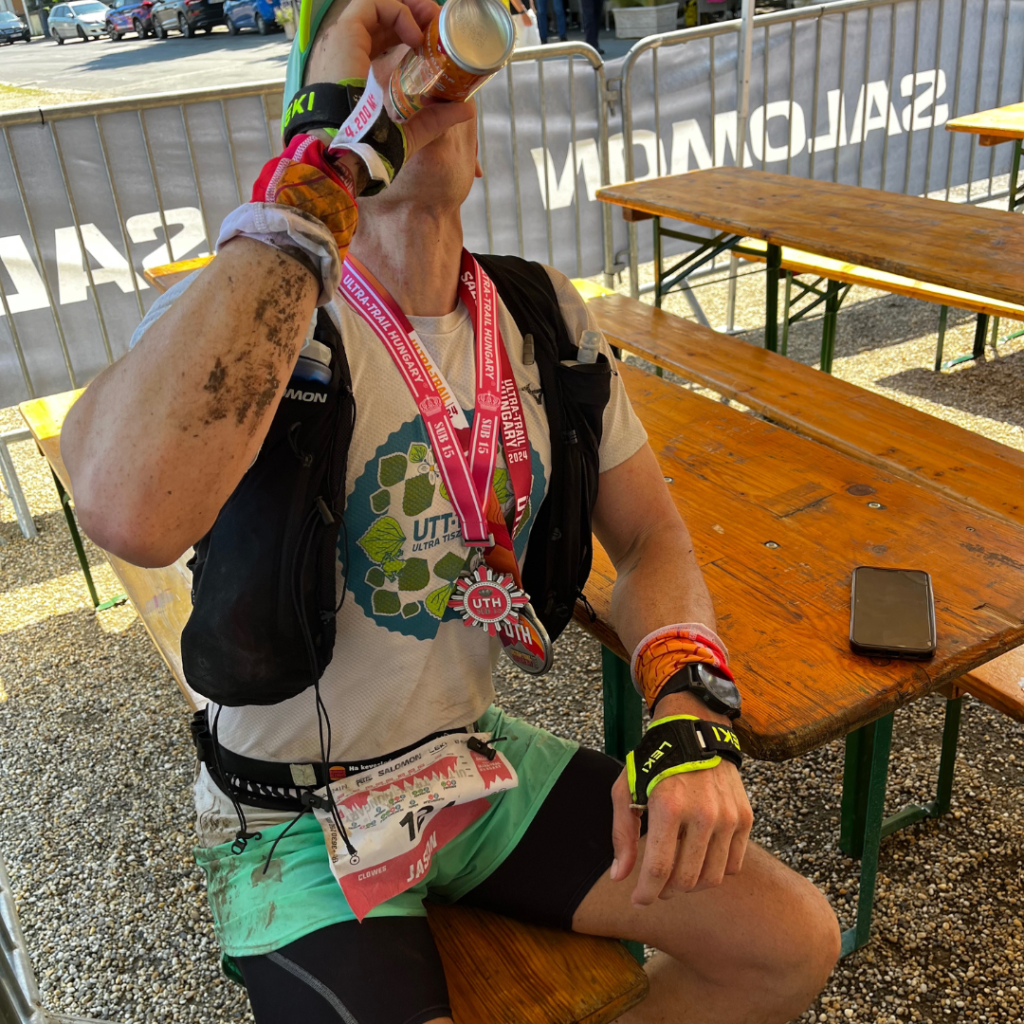
Closing Thoughts
I am genuinely pleased with my performance in the Ultra Trail Hungary 111km Race. Despite the lingering curiosity about how my result might have differed had I not participated in the UltraBalaton relay, I embrace the learning experience and the growth that came from this challenge. Completing the race in 14 hours and 27 minutes, securing 24th place out of 210 starters, and surpassing my previous year’s time by 25 minutes are achievements I am proud of.
For those contemplating an ultra race or even trail racing, the Ultra Trail Hungary is an excellent choice, offering a variety of distances to cater to different levels of experience and ambition. Whether you are an experienced ultra runner or someone looking to explore the trails for the first time, this event provides a welcoming and inclusive atmosphere.
If you’re uncertain about where to begin or need guidance on preparing for your next adventure, I’d be more than happy to help. Let’s have a conversation, and I can develop a tailored plan to coach you through your journey, ensuring you have the best possible experience on the trails.
